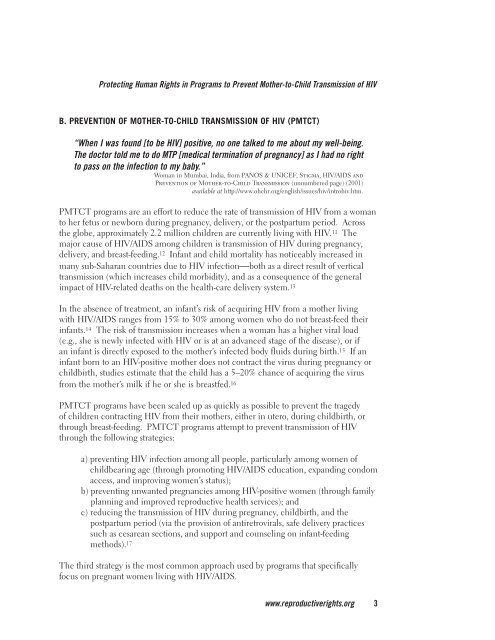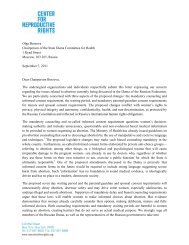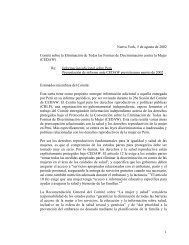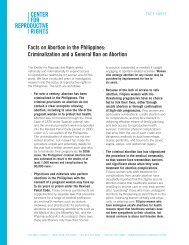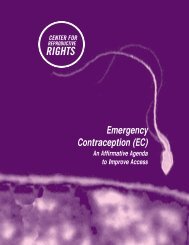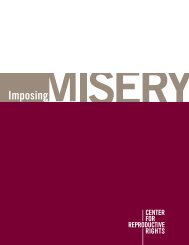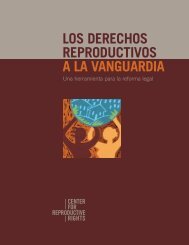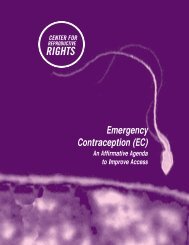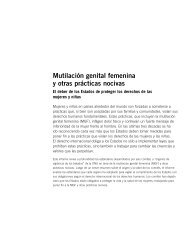Pregnant Women Living with HIV/AIDS: - Center for Reproductive ...
Pregnant Women Living with HIV/AIDS: - Center for Reproductive ...
Pregnant Women Living with HIV/AIDS: - Center for Reproductive ...
You also want an ePaper? Increase the reach of your titles
YUMPU automatically turns print PDFs into web optimized ePapers that Google loves.
Protecting Human Rights in Programs to Prevent Mother-to-Child Transmission of <strong>HIV</strong>B. PREVENTION OF MOTHER-TO-CHILD TRANSMISSION OF <strong>HIV</strong> (PMTCT)“When I was found [to be <strong>HIV</strong>] positive, no one talked to me about my well-being.The doctor told me to do MTP [medical termination of pregnancy] as I had no rightto pass on the infection to my baby.”Woman in Mumbai, India, from PANOS & UNICEF, Stigma, <strong>HIV</strong>/<strong>AIDS</strong> andPrevention of Mother-to-Child Transmission (unnumbered page) (2001)available at http://www.ohchr.org/english/issues/hiv/introhiv.htm.PMTCT programs are an ef<strong>for</strong>t to reduce the rate of transmission of <strong>HIV</strong> from a womanto her fetus or newborn during pregnancy, delivery, or the postpartum period. Acrossthe globe, approximately 2.2 million children are currently living <strong>with</strong> <strong>HIV</strong>. 11 Themajor cause of <strong>HIV</strong>/<strong>AIDS</strong> among children is transmission of <strong>HIV</strong> during pregnancy,delivery, and breast-feeding. 12 Infant and child mortality has noticeably increased inmany sub-Saharan countries due to <strong>HIV</strong> infection—both as a direct result of verticaltransmission (which increases child morbidity), and as a consequence of the generalimpact of <strong>HIV</strong>-related deaths on the health-care delivery system. 13In the absence of treatment, an infant’s risk of acquiring <strong>HIV</strong> from a mother living<strong>with</strong> <strong>HIV</strong>/<strong>AIDS</strong> ranges from 15% to 30% among women who do not breast-feed theirinfants. 14 The risk of transmission increases when a woman has a higher viral load(e.g., she is newly infected <strong>with</strong> <strong>HIV</strong> or is at an advanced stage of the disease), or ifan infant is directly exposed to the mother’s infected body fluids during birth. 15 If aninfant born to an <strong>HIV</strong>-positive mother does not contract the virus during pregnancy orchildbirth, studies estimate that the child has a 5–20% chance of acquiring the virusfrom the mother’s milk if he or she is breastfed. 16PMTCT programs have been scaled up as quickly as possible to prevent the tragedyof children contracting <strong>HIV</strong> from their mothers, either in utero, during childbirth, orthrough breast-feeding. PMTCT programs attempt to prevent transmission of <strong>HIV</strong>through the following strategies:a) preventing <strong>HIV</strong> infection among all people, particularly among women ofchildbearing age (through promoting <strong>HIV</strong>/<strong>AIDS</strong> education, expanding condomaccess, and improving women’s status);b) preventing unwanted pregnancies among <strong>HIV</strong>-positive women (through familyplanning and improved reproductive health services); andc) reducing the transmission of <strong>HIV</strong> during pregnancy, childbirth, and thepostpartum period (via the provision of antiretrovirals, safe delivery practicessuch as cesarean sections, and support and counseling on infant-feedingmethods). 17The third strategy is the most common approach used by programs that specificallyfocus on pregnant women living <strong>with</strong> <strong>HIV</strong>/<strong>AIDS</strong>.www.reproductiverights.org 3


